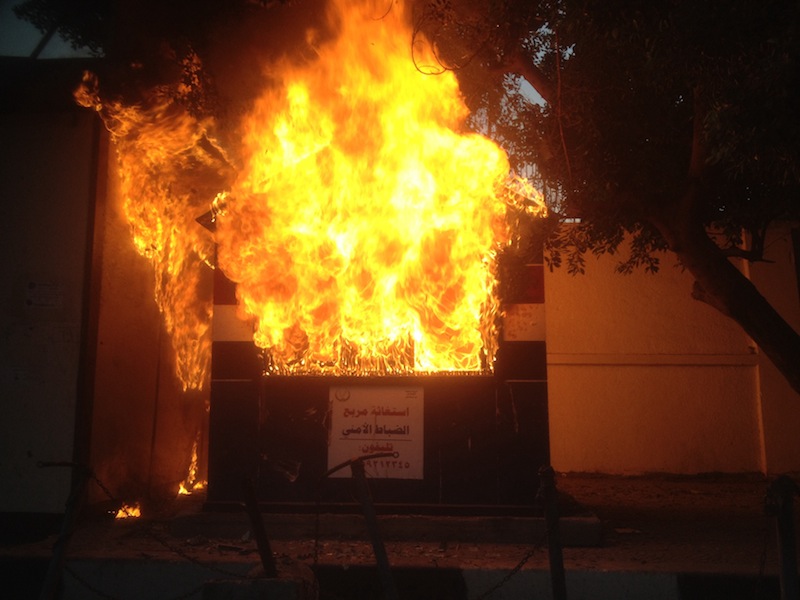With blood caked on his face and shirt, a young man in Giza attempted to direct traffic out of the way of marchers moving through a traffic circle north of the main thoroughfares of Dokki Street and Tahrir Street that had been the site of some of the bloodiest clashes in all of Giza and Cairo early on Sunday. Further down the road, a woman wearing full hijab cried uncontrollably on the sidewalk as someone tried to comfort her, while just off of Dokki Street there was a long, straight, trail of blood that ran for about a quarter of a block.
Sunday was Armed Forces Day, an annual celebration in Egypt of one of the most powerful militaries in the Middle East that includes military parades, aerial demonstrations and flag-waving. With the military having thrown out the ruling Muslim Brotherhood party and regained control over the Egyptian government this summer, Armed Forces Day was an opportunity for protest groups to take to the streets again.
And take to the streets they did, by the thousands.
In part of Dokki, a district of Giza, Egypt, that is just outside of Cairo, the police set up near the entrance to Dokki Square. They blocked the street with thin walls of sheet metal, large tear gas cannons and automatic weaponry. Protesters planned to converge on Tahrir Square in downtown Cairo, but the police had closed the Square itself, the bridges leading to the downtown area, and, likewise, had shut down the Metro station closest to the Square a few weeks prior in order to make it harder for activists to stage mass demonstrations there. Meanwhile in places like Dokki, police were dispatched to stop marchers from getting to Metro stations that might allow them to bypass the bridges and get to downtown anyway.
Protesters threw rocks over the barricade at the police officers who, in response, used live ammo, shooting indiscriminately into the crowd. Early in the clash, one man was shot in the head and dragged onto a side-street just off the front lines. As his friends tried to carry him on their shoulders he slipped and started to fall to the pavement, only for someone to catch his limp body and help drag it further away from the fighting.
The protesters were eventually chased down the street to a gas station shielded from tear gas by a building on its right. In what appeared to be an attempt to drive the protesters back, the police pushed the protesters toward the Dokki Bridge — opposite the gas station — until they could drive a truck directly across from the station and rain tear gas and bullets from above. Under heavy fire and gas attacks, everyone was forced to move further away from the main square. During the chaos, two Western journalists were arrested (though both were released by the evening).
Official casualties from the day of violence were more than 50 deaths and hundreds of wounded nationally, with the vast majority of those affected being in the Cairo-Giza metro area. Meanwhile, according to the Anti-Coup Alliance, a coalition of anti-military political parties in Egypt, the body count in Dokki alone was as high as 20. Sunday appears to have been the bloodiest day for Cairo since the violence in Raba’a back in August, when police had dispersed a month-long sit-in by Muslim Brotherhood supporters after the ouster of President Morsi.
As I passed through the traffic circle, what sounded like gunfire could be heard from behind, scattering the crowd, and pushing the protesters north. As the marchers passed by, Dokki residents peeked out timidly from behind their gates, while in the heart of the protest crowd, small groups of about five to 10 activists would stop and attempt to intimidate drivers and motorcycle riders passing through the crowd. Though there wasn’t any street fighting between this group of marchers and anti-Brotherhood groups, elsewhere throughout Dokki and the rest of the Cairo-Giza metro area, there were reports of skirmishes between armed anti-Brotherhood citizens trying to protect their neighborhoods against pro-Muslim Brotherhood demonstrators.
By the evening, I could still faintly smell tear gas around Dokki Square. A couple of young men were moving the sheet metal barricades police had erected out of the way, and a new group of demonstrators could be heard chanting from under Dokki Bridge, about half a block from where the front-lines had stood a few hours before.
“Sisi! Sisi!” they cried, praising the military leader Gen. Abdel Fattah el-Sisi who had taken over in the wake of the coup, to local TV cameras which had been set up to catch them in their nationalist revelry. Only numbering a few dozen, the pro-military protesters clumped together for their close-up, jumping up and down, dancing, waving propagandized posters of the general, and occasionally singing along with nationalist songs.
Slowly, nightlife returned to Dokki’s busy square, though, as people came out of their houses, lights in business windows were turned on, and people went about their routines. To the residents, the violence perhaps seemed unfortunately normal, a sign of the times over the past two years, and something that may not change anytime soon.
Jonathan Krohn is a freelance foreign correspondent based out of Cairo. His work has appeared in The Atlantic, Salon, and Mother Jones among many others. He was recently the Politics and International Affairs Fellow for Rudaw, a Kurdish media organization based out of Erbil, Iraq.
[Ed. note: TPM readers may remember him as a 13-year-old darling of American conservatives who later renounced his political affiliations.]







